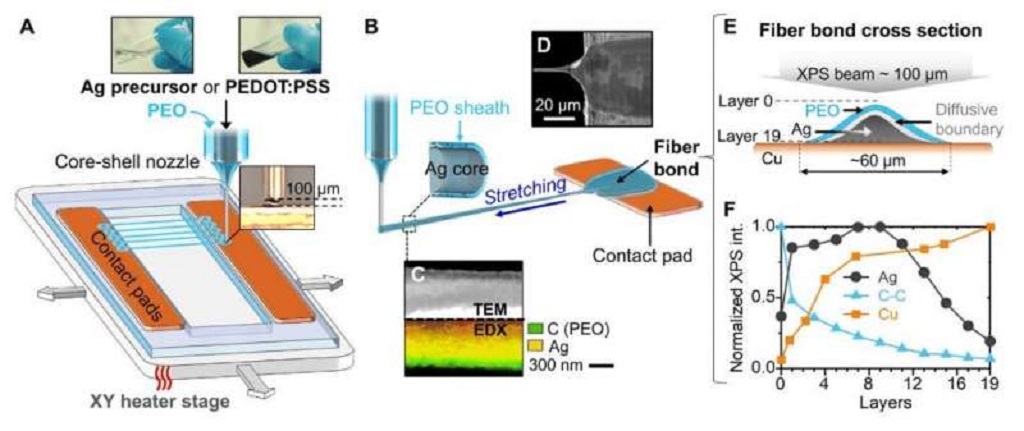
Using 3D printing technology, Researchers from the University of Cambridge created electronic fibers 100 times thinner than a human hair, making sensors with massively improved capabilities.
The 3D Printing Technique
According to the researchers’ paper, published in Science Advances, the 3D printing technique used to make these fibers can also be used to make non-contact, wearable, and portable respiratory sensors. They are cost-efficient, highly sensitive, and may be attached to a mobile phone for image and sound collection while simultaneously collecting breath pattern information. 3D printing “tiny, transparent conducting fibers” can help make devices able to “smell, hear, and touch”, which is especially useful in “health monitoring, Internet of Things, and biosensing applications”.
The first author of this article, Andy Wang, is a Ph.D. student from the Department of Engineering at Cambridge. He used the fiber sensor to measure the amount of breath moisture that leaked through his face covering for respiratory conditions (e.g., normal breathing, rapid breathing, and simulated coughing). These newly discovered sensors are said to have “significantly outperformed comparable commercial sensors, especially in monitoring rapid breathing, which replicates shortness of breath”.
The Applications Of The Research
With COVID-19 on our minds, lately “medical innovation” often means breakthroughs in viral research. While this particular fiber sensor wasn’t made to detect viral particles — as research indicates that viral particles like that of the novel coronavirus may be transmitted through respiratory droplets and aerosols — the measurement of the amount and direction of breath moisture leaking through different face coverings could indicate “weak points” in terms of the protection offered by these face coverings.
The most leakage was observed by this team in fabric or surgical masks from the front, primarily when coughing, whereas most leakage from N95 masks came from the top and sides with tight fittings. Regardless of this evidence, wearing either face mask properly helped weaken the flow of exhaled breath.
Dr. Yan Yan Shery Huang from the Department of Engineering at Cambridge led this research. She explained:
“Sensors made from small conducting fibers are especially useful for volumetric sensing of fluid and gas in 3-D, compared to conventional thin film techniques, but so far, it has been challenging to print and incorporate them into devices, and to manufacture them at scale.”
The 3D printed composite fibers created by Huang and her team were made from silver and/or semi-conducting polymers. This unique 3D printing technique creates a “core-shell fiber structure, with a high-purity conducting fiber core wrapped by a thin protective polymer sheath, similar to the structure of common electrical wires, but at a scale of a few micrometers in diameter”.
This technique may also be utilized for the creation of biocompatible fibers similar in dimension to biological cells, enabling them to guide cell movements. The miniscule sensors are invisible to the naked eye and hence, when they are used to connect small electronic elements in 3D, the electronic elements may seem to be floating in mid-air.
Future Directions
Huang comments:
“Our fiber sensors are lightweight, cheap, small and easy to use, so they could potentially be turned into home-test devices to allow the general public to perform self-administered tests to get information about their environments.”
The team behind this incredible innovation hopes to further develop their 3D printing technique to accommodate multi-functional sensors with the ability of detecting more breath species for mobile health monitoring or for bio-machine interface applications.
Thoughts On This Project
I think 3D printing technology is really cool when it comes to real world application and everyday applications. Especially with COVID-19 being a major problem across the world right now, I think everyone is looking for a way to alleviate that stress or problem in some way or the other. Although this creation wasn’t actually intended to detect viral particles, it’s great that it can analyze “leakage”. I think that could really help with redesigning personal protection or even just spreading awareness about how to achieve optimal protection from the personal protective equipment that people already own.
In addition to this, I really like the idea of mobile-monitoring, where it becomes easy for someone to keep track of their wellbeing, breathing habits, or symptoms, as even if someone doesn’t recognize any abnormalities with their breathing patterns, they will be notified at once.
Via TechXplore
